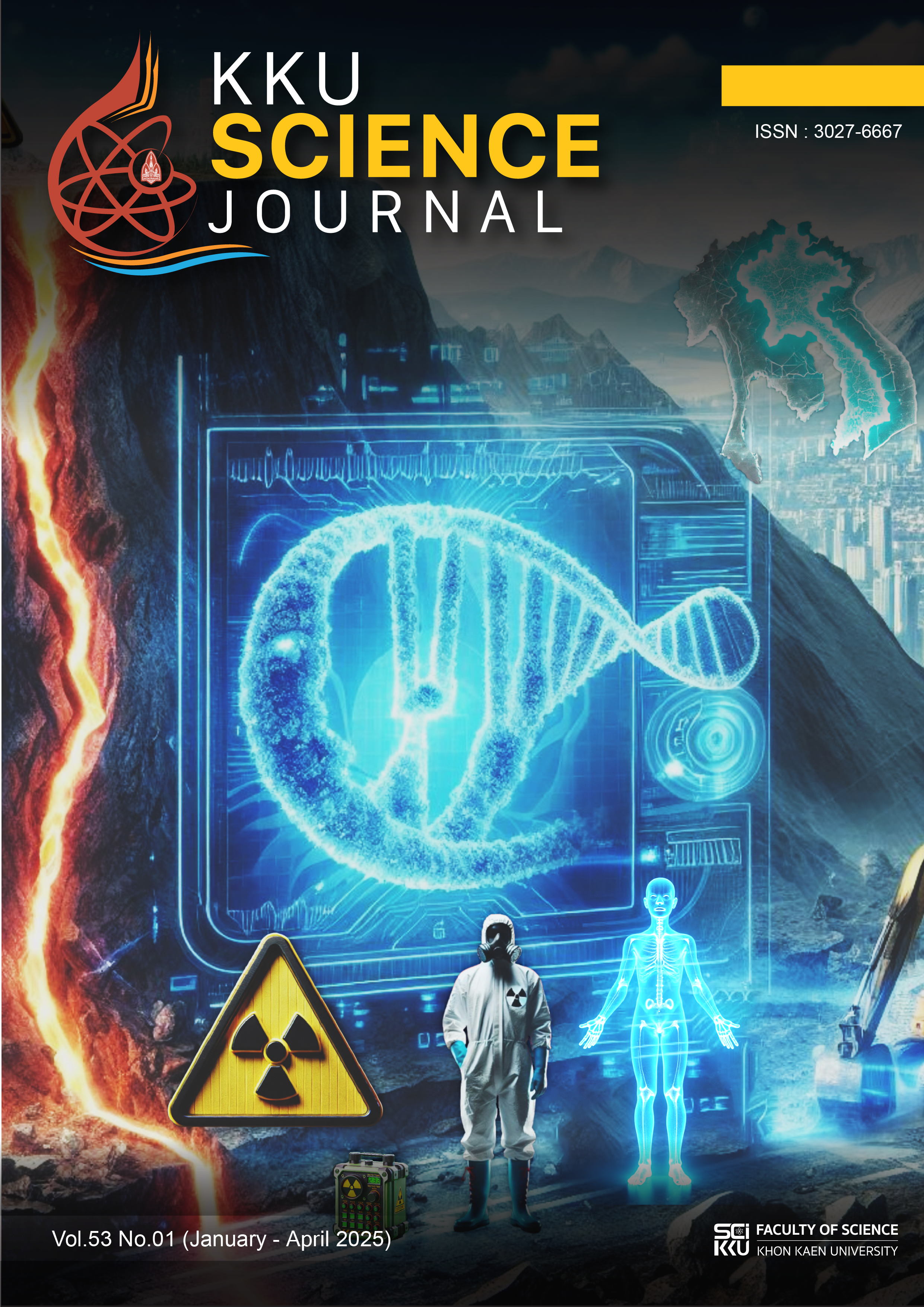ผลของกรรมวิธีการสกัดที่แตกต่างกันต่อคุณลักษณะของผงจิ้งหรีดทองดำ (Gryllus bimaculatus)
Main Article Content
บทคัดย่อ
งานวิจัยนี้มีวัตถุประสงค์เพื่อศึกษาคุณลักษณะทางเคมีกายภาพของผงจิ้งหรีดจากการสกัดด้วยวิธีที่แตกต่างกัน 3 วิธีของจิ้งหรีดทองดำ (Gryllus bimaculatus (De Geer, 1773)) ที่นิยมเลี้ยงเพื่อจำหน่ายทางการค้าของประเทศไทย ผลการทดลองพบว่า ภายหลังการสกัด 3 วิธี ได้แก่ การสกัดด้วยเอนไซม์โปรติเอสร้อยละ 3 การสกัดด้วยสารละลายเบส (0.5 M โซเดียมไฮดรอกไซด์) และการสกัดด้วยเอทานอลร้อยละ 99.5 ให้ปริมาณโปรตีนเพิ่มขึ้นเท่ากับร้อยละ 50.8 43.0 และ 42.7 ตามลำดับ อีกทั้งการสกัดด้วยเอนไซม์โปรติเอส มีปริมาณไขมันลดลงเท่ากับ 11.3 กรัม จาก 18.2 กรัม/100 กรัมน้ำหนักสดอย่างเห็นได้ชัด และมีความสามารถในการละลายสูงที่สุดเท่ากับ 93.55 ± 0.12 กรัม/ลิตร อย่างไรก็ตาม ร้อยละผลผลิตหลังการสกัดของผงจิ้งหรีดจากการสกัดด้วยเอทานอลมีปริมาณมากที่สุดเท่ากับร้อยละ 85.32 ± 0.12 รองลงมาได้แก่ ผงจิ้งหรีดจากการสกัดด้วยสารละลายเบสและเอนไซม์ (76.24 ± 0.34 และ 52.15 ± 0.45) การศึกษาคุณลักษณะด้วยสี พบว่าผงจิ้งหรีดจากการสกัดด้วยเอทานอลมีความสว่างมากที่สุดเท่ากับ 45.25 ± 0.21 ในขณะที่ผงจิ้งหรีดจากการสกัดด้วยสารละลายเบสมีความสว่างน้อยที่สุด (18.80 ± 0.06) เนื่องจากเอทานอลจัดเป็นสารละลายกลุ่มไม่มีขั้วที่มีความสามารถในการเป็นตัวทำละลายรงควัตถุในแมลงได้ จึงทำให้รงควัตถุละลายออกมากขึ้นในระหว่างการสกัดที่ใช้ระยะเวลาถึง 1 ชั่วโมง ดังนั้นการสกัดผงจิ้งหรีดด้วยเอนไซม์โปรติเอสร้อยละ 3 นอกจากให้ปริมาณโปรตีนหลังการสกัดที่สูงแล้วยังมีความสามารถในการละลายสูงและมีความสามารถในการดูดซับไขมันค่อนข้างต่ำ
Article Details

This work is licensed under a Creative Commons Attribution-NonCommercial-NoDerivatives 4.0 International License.
References
พงศ์พิพัฒน์ สนม และกมลวรรณ แจ้งชัด. (2563). ผลของจิ้งหรีดผง โปรตีนถั่วเหลืองสกัด และแซนแทนกัมที่มีต่อคุณภาพคุกกี้แป้งข้าวเจ้า. วารสารวิชาการและวิจัย มทร. พระนคร 14(2): 72 - 84.
ลีลา กญิกกนันท์ และจารึก ศักดิ์วัฒนกำจร. (2545). ชีววิทยาจิ้งหรีดเพื่อพัฒนาจัดการเพาะเลี้ยง. รายงานการประชุมวิชาการป่าไม้ประจำปี 2545. 341 - 349.
สุนีย์ สหัสโพธิ์. (2563). โปรตีนจากพืชหรือโปรตีนจากสัตว์ที่ดีต่อสุขภาพ. วารสารเทคโนโลยีคหกรรมศาสตร์ มหาวิทยาลัยเทคโนโลยีราชมงคลพระนคร 2(2): 97 - 101.
สุดา ชูถิ่น, กาญจนา เหลืองสุวาลัย และอังสุมา แก้วคต. (2567). ผลของการใช้ผงจิ้งหรีดและแป้งข้าวดัชนีน้ำตาลต่ำทดแทนแป้งสาลีต่อคุณลักษณะทางกายภาพและเคมีของคุ้กกี้เนยกระเทียม. วารสารวิทยาศาสตร์และนวัตกรรมการเกษตร55(2): 122 - 136.
Amarender, R.V., Bhargava, K., Dossey, A.T. and Gamagedara, S. (2020). Lipid and protein extraction from edible insects – Crickets (Gryllidae). LWT- Food Science and Technology 125: 109222. doi: 10.1016 /j.lwt.2020.109222
AOAC International. (2023). Official methods of analysis of AOAC INTERNATIONAL. (22nd ed). Maryland, U.S.A.
Cunha, N., Andrade, V., Macedo, A., Ruivo, P. and Lima, G. (2025). Methods of Protein Extraction from House
Crickets (Acheta domesticus) for Food Purposes. Foods 14(7): 1164.
De Geer, C. (1773). In Mémoires pour servir à l'histoire des insectes. Pierre Hesselberg, Stockholm 696(3): 44.
Gahukar, R.T. (2011). Entomophagy and human food security. International Journal of Tropical Insect Science 31(3): 129 – 144.
Hall, F.G., Jones, O.G., O’Haire, M.E. and Liceaga, A.M. (2017). Functional properties of tropical banded cricket (Gryllodes sigillatus) protein hydrolysates. Food Chemistry 224: 414 – 422 doi: 10.1016/j.food chem.2016.11.138.
Hanboonsong, Y., Rattanapan, A. Waikakul, Y. and Liwavanich, A. (2001). Edible Insect Survey in Northeastern Thailand. Khon Kaen Agriculture Journal 29(1): 35 - 44.
Hassan, S.A., Altemimi, A.B., Hashmi, A.A., Shahzadi, S., Mujahid, W., Ali, A., Bhat, Z.F., Naz, S., Nawaz, A.,
Abdi, G. and Aadil, R.M. (2024). Edible crickets, as a possible way to curb protein-energy malnutrition: Nutritional status, food applications, and safety concerns. Food Chemistry: X 23: 101533. doi: 10.1016/j.fochx.2 024.101533.
Hirsch, A., Cho, Y.H., Kim, Y.H.B. and Jones, O.G. (2019). Contributions of protein and milled chitin extracted from domestic cricket powder to emulsion stabilization. Current Research in Food Science 1: 17 - 23. doi: 10.1016/j.crfs.2019.09.002.
Jia, C., Cao, D., Ji, S., Lin, W., Zhang, X. and Muhoza, B. (2020). Whey protein isolate conjugated with xylooligosaccharides via maillard reaction: Characterization, antioxidant capacity, and application for lycopene microencapsulation. LWT- Food Science and Technology 118: 108837. doi: 10.1016/j. lwt.2019.108837.
Kim, T.K., Yong, H.I., Kim, Y.B., Jung, S., Kim, H.W. and Choi, Y.S. (2021). Effects of organic solvent on functional properties of defatted proteins extracted from Protaetia brevitarsis larvae. Food Chemistry 336: 127679. doi: 10.1016/j.foodchem.2020.127679.
Laicharting, J.N.E. (1781). Verzeichniß und Beschreibung der Tyroler-Insecten I Theil Käferartige Insecten I Band. In SUB Göttinger Digitalisierungszentrum (online). Source: http://www.animalbase.uni-goettin gen.de/zooweb/servlet /AnimalBase/home/reference?id=2081. Retrieved date 19 April 2025.
Linnaeus, C.N. (1758). In Systema Naturae per Regna tria naturae (10th ed.). Holmiae. 1: 824.
Mishyna, M., Chen, J., and Benjamin, O. (2019). Sensory attributes of edible insects: A comprehensive review,trends and future prospects. Food Research International 126. 108672.
Ndiritu, A.K., Kinyuru, J.N., Kenji, G.M. and Gichuhi, P.N. (2017). Extraction technique influences the
Physico-chemical characteristics and functional properties of edible crickets (Acheta domesticus)
protein concentrate. Journal of Food Measurement and Characterization 11(4): 2013 – 2021.
Osimani, A., Milanovic, V., Cardinali, F., Roncolini, A., Garofalo, C., Clementi, F., Pasquini, M., Mozzon, M., Foligni, R., Raffaelli, N., Zamporlini, F. and Aquilanti, L. (2018). Bread enriched with cricket powder (Acheta domesticus): A technological microbiological and nutritional evaluation. Innovative Food Science and Emerging Technologies 48: 150 – 163. doi: 10.1016/j.ifset.2018.06.007.
Pawlak, R., Lester, S.E. and Babatunde, T. (2014). The prevalence of cobalamin deficiency among vegetarians assessed by serum vitamin B12: a review of literature. European Journal of Clinical Nutrition 68: 541 - 548. doi: 10.1038/ejcn.2014.46.
Rumpold, B.A. and Schlüter, O.K. (2013). Nutritional composition and safety aspects of edible insects. Molecular Nutrition & Food Research 57(5): 802 - 823. doi: 10.1002/mnfr.201200735.
Sillero, J., Gharsallaoui, A. and Prentice, C. (2018). Peptides from Fish By-product Protein Hydrolysates and
Its Functional Properties: an Overview. Marine Biotechnology 20: 118 - 130.
Udomsil N., Imsoonthornruksa, S., Gosalawit, C. and Ketudat-Cairns, M. (2019). Nutritional Values and Functional Properties of House Cricket (Acheta domesticus) and Field Cricket (Gryllus bimaculatus). Food Science and Technology Research 25(4): 597 - 605. doi: 10.3136/fstr.25.597.
Vibulsresth P., and Trevanich S. (2003). Microorganism in Food. In. Food Science and Technology. Bangkok: Kasetsart University Publishing. 48 - 64.
Yi, L., Lakemond, C.M.M., Sagis, L.M.C., Eisner-Schadler, V., van Huis, A., and van Boekel, M.A.J.S. (2013). Extraction and characterisation of protein fractions from five insect species. Food Chemistry 141(4): 3341 -3348. doi: 10.1016/j.foodchem.2013.05.115.
Yu, L., Yang, W., Sun, J., Zhang, C., Bi, J. and Yang, Q. (2015). Preparation, Characterization and Physicochemical Properties of the Phosphate Modified Peanut Protein Obtained from Arachin Conarachin L. Food Chemistry 170: 169 - 179. doi: 10.1016/j.foodchem.2014.08.047.
Zhao, X., Vázquez-Gutiérrez, J.L., Johansson, D.P., Landberg, R., and Langton, M. (2016). Yellow Mealworm Protein for Food Purposes - Extraction and Functional Properties. PLoS ONE 11(2): e0147791. doi: 10.1371/journal.pone.0147791.

